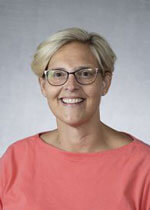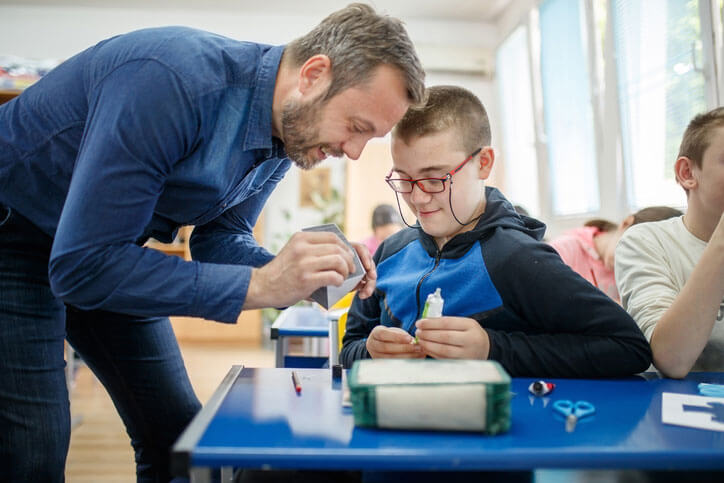There’s nothing more soothing than blowing off steam with a coworker. In between embarrassing early-career anecdotes and tales of tough situations that worked out in the end, you may even accidentally stumble across a solution to your latest problem. Sometimes, these quick, informal chit chats are more productive than hours-long meetings.
But for special education teachers, these moments can be hard to find.
“It can be a very isolated, lonely place as a special educator,” says seasoned teacher Professor Kharon Grimmet of Purdue University. “Especially if we’re the only special education teacher in the building. We just need that camaraderie to stay focused on what our purpose is.”
Unfortunately, Professor Grimmet’s experience in professional solitude isn’t rare. In 2021, a team of researchers combed through US Department of Education data and found that 49 states reported special education teacher shortages that year. So in almost every corner of the country, students with intellectual disabilities aren’t getting the support they deserve. And neither are their families, their communities, or their teachers.
As Purdue’s Online Special Education Program Coordinator, Professor Grimmet is working hard to rectify this systemic issue. She and her colleagues aren’t just shaping each of their candid ates as individual teachers. They’re equipping them to build an educational community built on trust, mutual respect, and, most importantly, collaboration.
In a recent interview with Masters-in-Special-Education.org, Professor Grimmet outlined how a collaborative approach to teaching isn’t just vital for the future of special education, but education in general.
 When it comes to education, it would be hard to find a more well-rounded professional than Professor Kharon Grimmet. She’s been a life skills teacher, a fourth grade teacher, and an inclusion teacher. For nine years, she served on the Council for Exceptional Children and was even the President of the council’s Division of Physical, Health, and Mental Disabilities. She’s been with Purdue University since 2014 where she currently serves as a coordinator and instructor in the special education program. Her numerous research endeavors include the paper “Bill is now singing,” an examination of how improvisational musical therapy can foster social engagement in children with autism.
When it comes to education, it would be hard to find a more well-rounded professional than Professor Kharon Grimmet. She’s been a life skills teacher, a fourth grade teacher, and an inclusion teacher. For nine years, she served on the Council for Exceptional Children and was even the President of the council’s Division of Physical, Health, and Mental Disabilities. She’s been with Purdue University since 2014 where she currently serves as a coordinator and instructor in the special education program. Her numerous research endeavors include the paper “Bill is now singing,” an examination of how improvisational musical therapy can foster social engagement in children with autism.
What Is Collaboration in Education?
Broadly speaking, collaboration simply means multiple people, often with different talents, working together towards a common goal. But in education, collaboration refers to a specific teaching strategy in which all stakeholders (teachers of all types, administrators, family members, students, etc.) take active parts in student development. It’s a holistic method that aims to meet students’ educational, emotional, and social needs.
Common collaborative teaching strategies include:
- Asking for input from a student’s former teacher.
- Working with administrators to source alternative learning materials.
- Giving parents active, meaningful ways to be involved.
- Devising coordinated lesson plans in groups instead of individually, referred to as common planning time.
- Using self-guided learning strategies like problem-solving projects, group discussions, and peer teaching to keep students engaged socially and academically.
- Utilizing and collaborating with school counselors.
To Professor Grimmet, these strategies break down hierarchical barriers between education professionals and keep the focus on students:
“It’s not about a degree. It’s not about a license. It’s about doing the best we can, providing the best services we can for our learners regardless of whether they’re in preschool, elementary, middle school, or high school. We’ve got a lot of work to do just to be able to support them through that, and encourage them.”
So while each teacher has their own domain like math or social studies, their duties are fluid. There’s no “Good luck with that!” or “She’s a special education student. Not my problem.” Everyone takes responsibility for every student. And with that attitude, schools transform from institutions into communities, places where ideas are shared and support is always there.
Bridging the Gap Between General and Special Education Teachers
General and special education are often seen as two distinct domains. However, Professor Grimmet believes teachers from both areas can do a lot to help each other:
“I truly believe I was a better general education teacher because I was a special education teacher. Special education can be difficult. And so you’ve got to have those opportunities in those moments, those relationships with families, with students, and with administration that help you to grow and to continue going on.”
To illustrate Professor Grimmet’s point, think about a student with autism. This student may face issues with sensory overload, communication, adjusting to new routines, and skill acquisition. Their special education teacher will likely have to go to the administration to find alternate learning materials. They’ll have to keep in touch with family members about sensory and behavioral issues. Along the way, they’ll also have to find ways to bond with the student and foster social engagement with other students. In doing so, the teacher keeps themself and their student in touch with the community at large.
Now imagine a student without any diagnosed learning disabilities struggling with long division. It’s not just an academic matter. The student seems to be acting out more and becomes disengaged with the class. What’s an overworked teacher with a full class to do?

In a collaborative teaching environment, the answer could be to look to the special education teacher for help. Not necessarily because the student might have a learning disability, but because the special education teacher is likely to be comfortable with collaborative teaching strategies and conflict resolution. In fact, Professor Grimmet herself has been on both sides of this issue:
“I call it the ‘Jekyll and Hyde.’ When I was that gen ed teacher, I was just kind of stuck in those conflicts: ‘What do I do? What do we do?’ And as a special ed teacher, I’ve experienced collaborating with Gen. Ed teachers and the integration pieces.”
Data from the National Center for Learning Disabilities underscores just how important this cooperation is. According to their 2017 report:
- About 20% of children have learning or attention issues.
- Millions of children have unidentified learning and attention issues.
- Only 1 in 16 public school students receive help for specific learning disabilities through Individualized Education Programs (IEPs).
- 33% of educators believe learning and attention problems are actually just laziness.
In light of those troubling statistics, it becomes apparent that general/special education teacher collaboration isn’t just about sharing strategies, but fostering open, unstigmatized dialogue about learning. That alone can create compassion, drive research, and bring the nation’s educational issues in front of policymakers. Maybe then, special education teachers wouldn’t have to feel the isolation Professor Grimmet felt earlier in her career. Instead, they could have resources to use and a tight-knit community to rely on.
Collaborative Teachers Are There for Families, Too
The National Center for Learning Disabilities report included another troubling piece of data: 43% of surveyed parents said they wouldn’t want others to know if their child had a learning disability. There might be some shame and fear of judgment hidden behind that number, but in a country with such limited special education resources, are those emotions such an unreasonable response?
A 2022 study published by the Journal of Child and Family Studies highlights how parents raising children with disabilities suffer from higher rates of anxiety, depression, stress, and guilt. Many of these parents also struggle to see themselves as good caregivers and grapple with forgiving themselves for perceived shortcomings.
In Professor Grimmet’s experience, supporting families through those complicated emotions is key to the collaborative teaching pedagogy:
“Integrating general education and special education practices ultimately helps to support families. There are a lot of times where we’re tired, as teachers and humans. This is a very emotional profession, and so we can be tired and we can be exhausted. It’s easy to put those relationships with parents aside, but those are so key and so important.”
But like other aspects of collaborative teaching, parent-teacher relationships shouldn’t be one-sided.
According to a 2022 research review conducted by the Family Engagement Center at Ohio State University, relationships that emphasize parents as experts in their child’s wellbeing can open dialogues, foster meaningful engagement, and help parents and teachers alike feel more empowered.
Similarly, parents of children with disabilities in schools with high levels of parent involvement often form peer support groups. These formal and informal groups can not only remove isolation, but prevent special education teachers from being the sole source of parent support and guidance — an essential ingredient to making special education more inclusive, accessible, and equitable.
Creating Collaborative Teachers in Special Education and Beyond
As coordinator of program, Professor Grimmet makes sure her students don’t see IEPs as legal requirements, parent interactions as burdens, or teacher collaboration as an emergency plan. Instead, she wants future teachers to see these things as opportunities for understanding and self-reflection:
“As we developed our program at Purdue, we were intentional. You’re not just writing an IEP, you’re learning about the components of an IEP and why they’re important.”
So along with courses about curriculum design and educational research, the program also offers courses about how to help students transition through different stages in development and the social, ethical, and legal issues that inevitably arise. The program, and other collaboration-centered programs like it, focuses on discerning each student’s needs instead of generalized concepts about special education. To an experienced educator like Professor Grimmet, this is the heart of what it means to be a special educator:
“We have to know our learners because they’re not in a box. They’re individuals. And that’s what makes special education special.”

